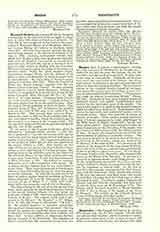

Hosius of Cordova, the foremost Western champion of orthodoxy in the early anti-Arian struggle; b. about 256; d. about 358, either at Sirmium or in Spain. In early life he was a confessor of the Faith in the persecution of Maximian (Morse) or of Diocletian (Hefele), and became Bishop of Cordova in Southern Spain about 295. His name is mentioned amongst the nine-teen bishops present at the provincial Council of Elvira (c. 300). Leclercq enumerates certain facts which show Hosius to have been in close personal relations with the Emperor Constantine on several occasions between 313 and 324, and he is known to have been his chief adviser in dealing with the Donatists. We have nothing to explain the origin of the connection between them. When the Arian troubles began, Constantine charged Hosius with the delivery offhis letter to Arius and Alexander, in which he urged them to reconciliation. We know little of Hosius’s action during this mission (323-324). When the Council of Nicaea met, Hosius presided, together with the two Roman priests Vitus and Vincent. In what capacity he presided is a matter much discussed: Gelasius of Cyzicus is categorical in declaring that it was in the name of the pope (Hist. Nic. Conc., Bk. II, c. v). Hefele is of the same opinion. Chapman holds that he was nominated by Constantine. Leclercq inclines to the same opinion, but leaves the question open. After the council, Hosius probably returned to Spain. Constantine dying, May 22, 337, Athanasius was recalled from his first exile in 338, only to be expelled by the Arians in 340. After passing three years in Rome, Athanasius went in 343 into Gaul to confer with Ho-thus, and thence to Sardica, where the council began in the summer, or, at latest, in the autumn of 343. Hosius presided, proposed the canons, and was the first to sign the Acts of the council.
In the letter of the Council of Sardica, given in Athanasius, “Apologia contra Arians”, c. xliv, Ho-sins is spoken of as “one who on account of his age, his confession, and the many labors he had undergone, is worthy of all reverence”. The suggested explanation of the symbol of Nicrea did not meet the approval of the council (Hefele, p. 758). After Sardica we lose sight of him for ten years, until Pope Liberius‘s letter to him (c. 353), after the fall of Vincent of Capua. The prestige given to the orthodox cause by the support of the venerable Hosius led the Arians to bring pressure to bear upon Constantius II, who had him summoned to Milan (Gwatkin, p. 292). He declined to condemn Athanasius or to hold communion with Arians. He so impressed the emperor that he was authorized to return home. More Arian pressure led to Constantius writing a letter demanding whether he alone was going to remain obstinate. In reply Hosius sent his brave letter of protest against imperial meddling in Church affairs, preserved for us by St. Athanasius (Hist. Arianorum, 42-45, cf. Migne, P.L., VIII, 1327-1332), which led to his summons (end of 353) to Sirmium.
The facts relating to the end of his life are far from clear; under pressure, he signed the declaration known as the second Sirmian formula (the first being the profession of faith of 351), which was published as the formula of Hosius. The original Latin text is preserved in St. Hilary’s “De Sy nodis”, c. XI (Migne, P.L., X, 598), the Greek, in Athanasius: “De Syn.”, 28. He refused, however, to renounce Athanasius, who speaks of him as lapsing “for a moment”; having served the purpose for which the Arians brought him to Sirmium, he was probably taken back to Spain, and there died. A later addition to Athanasius declares that he recanted on his deathbed. The defenders of Hosius contend that the concession wrung from himhas been much magnified and misrepresented. But it is contended that Athanasius cannot have had all the facts before him when he wrote, and that the second Sirmian formula is clearly heterodox.
EDWARD MYERS

